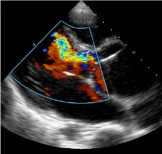The Marfan syndrome is a genetic condition affecting the joints and supporting structures of the body. This can lead to abnormalities in the heart including in the main blood vessel leaving the heart (the aorta). If this vessel enlarges then it can increase the risk of the blood vessel splitting or rupturing. Patients with the Marfan syndrome are often tall with long arms and/or fingers.

How common is it?
Marfan syndrome affects approximately 1 in 3500 of the population.
What symptoms might I get?
Patients with the Marfan syndrome usually have no symptoms.
Will I need treatment?
There are some medications that may reduce the risk of aortic vessel enlargement. In patients in whom the aorta enlarges significantly, surgery can be recommended.
What extra tests are required?
Most patients require a heart ultrasound (echocardiogram) to examine the heart structure, valves and size of the aorta. A computed tomography (CT) or magnetic resonance imaging (MRI) scan can provide more information about this.
Is it hereditary?
There can be a genetic link in Marfan syndrome and in most families it is passed on from generation to generation. For that reason, if you have been diagnosed with the Marfan syndrome we recommend that your immediate relatives be screened for the condition. Genetic testing can occasionally be helpful.
Does this affect my life expectancy?
Aortic rupture is a recognised cause of death in patients with Marfan syndrome but with monitoring and appropriate use of medication and surgery, life expectancy should not be affected.
What happens next?
If you have been diagnosed with the Marfan syndrome then you can be offered an appointment with a local cardiologist to discuss the role of further imaging and investigation.
Useful links
https://en.wikipedia.org/wiki/Marfan_syndrome
Marfan association: http://www.marfan-association.org.uk